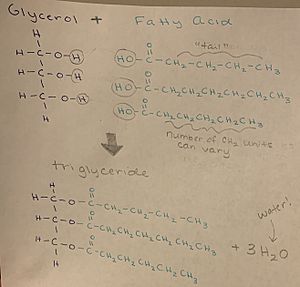Triacylglyceride facts for kids
A triglyceride (also called TAG) is a type of fat or oil. Triglycerides are very important for our bodies. They are the main way our bodies store energy. You can find triglycerides in body fat, in vegetable oils, and even in your blood.
Triglycerides are made of three fatty acids connected to a molecule called glycerol. Imagine glycerol as a backbone and the three fatty acids as long tails attached to it. These long tails are made mostly of carbon and hydrogen atoms. They don't mix well with water, which is why oil and water separate. The longer these fatty acid tails are, the more energy the triglyceride can store.
Contents
Types of Triglycerides
There are two main types of triglycerides: saturated fats and unsaturated fats. They are different in their chemical structure and how they behave.
Saturated Fats Explained
Saturated fats have carbon atoms that are "saturated" with hydrogen atoms. This means each carbon atom has as many hydrogen atoms as it can hold. Because of this, saturated fats are usually solid at room temperature. Think of butter or the fat on meat. They also have a higher melting point. Saturated fats provide a lot of energy to the body.
Unsaturated Fats Explained
Unsaturated fats are different because they have at least one double bond between carbon atoms. This means they have fewer hydrogen atoms compared to saturated fats. Because of these double bonds, unsaturated fats are usually liquid at room temperature. Most oils, like olive oil or sunflower oil, are unsaturated fats. They have a lower melting point than saturated fats.
How Your Body Uses Triglycerides for Energy
Triglycerides are like tiny energy banks in your body. When your body needs energy, it breaks down these stored triglycerides.
Breaking Down Triglycerides
First, triglycerides are broken down into smaller pieces. These pieces are then turned into a molecule called Acetyl-CoA (acetyl coenzyme A). This is a key step in getting energy from fats.
Energy Production Cycle
Acetyl-CoA then enters a special process called the Krebs cycle. This cycle is like a tiny power plant inside your cells. It works to create energy that your body can use for everything you do, from running and playing to thinking and breathing. The Krebs cycle is the same process that helps your body get energy from carbohydrates, like the bread and sugar you eat.
Images for kids
-
Example of an unsaturated fat triglyceride (C55H98O6). Left part: glycerol; right part, from top to bottom: palmitic acid, oleic acid, alpha-linolenic acid.
See also
 In Spanish: Triglicérido para niños
In Spanish: Triglicérido para niños



